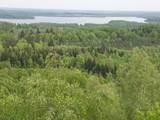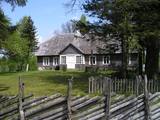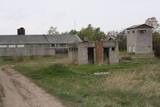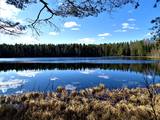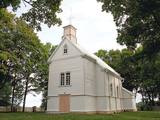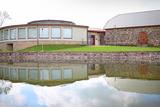| Nr | Name | Beschreibung |
|---|---|---|
|
Dieses Territorium soll die Hügel und Seen des Hochlandes von Augšzeme schützen – die Seen Svente, Medums, Ilga und andere mit ihren Inseln, Landschaften und Arten. Der Naturpark, der um die Seen Svente und Medums herum eingerichtet wurde, ist Teil dieses Territoriums und es gibt mehrere Gebiete, die aus Umweltgründen geschützt werden – die Seen Bardinskis und Skujine und die Inseln der Seen Medums und Svente. Es gibt einen Aussichtsturm auf dem Egļukalns - Berg und Abfahrtsski-Routen.
|
||
|
Das Museum wurde 1991 gegründet. Im Geburtshof von S. Darius wurden Haus und Speicher der Eltern wiederaufgebaut. In beiden Gebäuden gibt es jetzt Ausstellungen. In einem erzählt die Ausstellung über die Geschichte der Luftfahrt in Litauen und das Leben von Darius, während die andere Ausstellung dem traditionellen niederlitauischen Haushalt gewidmet ist. Neben dem Museum gibt es einen Campingplatz, wo man sich erholen und auch für längere Zeit niederlassen kann.
|
||
|
Der Nationalpark Matsalu (48 610 ha) wurde als Schutzgebiet für die zahlreichen Vogelarten eingerichtet. Im 1976 wurde Matsalu zu der bedeutendsten Feuchtgebiete der Welt aufgenommen und auf die Ramsar Liste eingetragen. Matsalu ein wichtiger Zwischenstopp für Zugvögel und ein Nistplatz für viele Watvögel und gehört zu den populärsten Vogelbeobachtungsgebieten in Europa. Hier gibt es viele Naturpfade und 8 Vogelbeobachtungstürme. Vogelbeobachtungstouren und Pauschalen für Familien, sowie Kanuwanderungen in Matsalu bietet der Reiseveranstalter Estonian Nature Tours (www.naturetours.ee). |
||
|
Tagadējais dievnams (iepriekšējie celti 1652. un 1776. g.) būvēts laikā no 1839. - 1842. g. Vidzemē pazīstamā lībiešu būvmeistara Mārča Sāruma (1799. –1859.) vadībā. Par prototipu tam izmantoja Pievolgas vācu koloniju baznīcu veidolu. Dievnama altārī atrodas Pītera Paula Rubensa gleznas “Kristus pie krusta” kopija (oriģināls – Minhenē), ko 1887. g. baznīcai uzdāvināja Nēķena muižas īpašniece. Baznīcas remonta laikā (1928. g.) atklāja piemiņas plāksnes 1. pasaules karā un Latvijas Brīvības cīņās kritušajiem. Blakus baznīcas atrodas viduslaiku kapsēta. Celtnes autors un būvdarbu virsuzraugs - H. fon Hagemeistars esot teicis, ka šis dievnams esot „vienīgā baznīca visā Vidzemē un varbūt arī pasaulē, kas uzcelta bez apreibināšanās”. |
||
|
Eine der ältesten Kirchen Lettlands, gebaut im 13. Jh. nach der Eroberung von Kubesele. |
||
|
Im Nordenvon Rubeņi – an den Ufern des Flusses Dzirnavupīte – ist ein Park mit landschaftlichen Teichen, einer Bühne, einem Steingarten und Kinderspielplätzen eingerichtet worden. Mit der Einrichtung des Parks wurde in den 1950er Jahren begonnen. An dem Kulturhaus, das sich in dem Park befindet, ist das während der Tage der Dichtung von 1969 enthüllte Denkmal des Schriftstellers Rainis (Autor, Bildhauer Kārlis Baumanis) gesetzt worden. |
||
|
The brothers Imants and Ivars Novožilovs have spent more than 10 years collecting local evidence of World War II – weapons, wrecks of armoured vehicles, the everyday objects of soldiers, etc., and they have now opened an exhibition of those items at the former headquarters of the local parish council.
|
||
|
Lahemaa bedeutet auf estnisch “Land der Buchten“. Der erste Nationalpark im Baltikum (1971). Der Park wurde für den Schutz der biologischen Vielfalt, Inseln, geologischen Objekte, archeologischen Denkmäler, Landgüter, Fischerdörfer u.a. gegründet. |
||
|
Im Restaurant am Ufer des schönen südestnischen Sees Pühajärve können Sie die vom Chefkoch zubereiteten erstklassigen Gerichte genießen. Vor allem werden frische örtliche Produkte verwendet. Es werden auch besondere Kochveranstaltungen organisiert. |
||
|
Meklējama Skaistkalnes dienviddaļā, Mēmeles labajā krastā, Skolas ielā 5. Vietvārds Šēnberga tulkojums no vācu valodas nozīmē „Skaistais kalns”. No sarkanajiem ķieģeļiem celtā divstāvu muižas pils (historisma stils) tapusi ap 1894. g. (arhitekts Pauls Makss Berči). Ēkā ir saglabājušies dekoratīvās apdares elementi un iespaidīgs kamīns (vienīgais tāds Latvijā), uz kura atainota dzimtbūšanas atcelšanu Latvijā. Kamīnzālē atrodas pirms četriem gadiem atjaunotais griestu plafons. Muižas pilī atrodas Skaistkalnes vidusskola. Muižu ietver parks, kurā atrodas citas ar muižu saistītās ēkas. |
||
|
The farmwoman grows vegetables and fruits to produce tasty preserves, syrups, jams, chutneys and dried fruit. You can taste and purchase the products, go on a tour of an escargot farm, and taste escargots cooked in the Burgundy style. Children’s camps can be organised. |
||
|
Die ehemalige Meldegängerabteilung in Pļavmalas wird zur Zeit als Lager für die Landwirtschftsprodukte genutzt. Das Objekt ist im Besitz von einem Bauernhof.
|
||
|
Heimarbeiter bieten an, verschiedene Käsespezialitäten zu kaufen, die auf den grünen Märkten in Gulbene und andernorts in Lettland zu finden sind. Annahme der Bestellungen. |
||
|
Ķekavas novadā, Daugmales pagastā atrodas jauka atpūtas vieta - Lejas ezers. Ezeram var apiet apkārt, taka nav marķēta un iešana ir pa mazām meža taciņām. Slapjākā laikā taciņas vietām var būt mitras un dubļainas. Pastaiga aizņems aptuveni stundu. Pie ezera ir iekārtotas vairākas piknika vietas. |
||
|
The Atāli homestead is on Putnu Island, and a local researcher, Ārija Gruberte, has used the threshing barn to exhibit everyday objects used in the area of the ancient Dviete River valley over the course of time. She has collected these items over the course of 20 years, and they include objects dating back to the Stone Age, the Iron age and the Middle Ages. All of them speak to human lives over the course of more than 10,000 years. Please call in advance to arrange for a tour. |
||
|
One of the rare guides in Latgale who sings Lettigalian songs during the tour. This is an interesting, attractive and educational tale about historical events related to the Preiļi Estate and the surrounding town. |
||
|
Roman Catolic Church of Puša was built in 1743. Financed by Count Šadurskis; managed by Jesuits
mission. There is on organ and 3 altars in the church.
|
||
|
The cafe Kolumbine is situated in the suburb of Talsi city, about 1,5 km away from the centre. |
||
|
Võrumaa’s first small beer brewery produces a delicious beer that has specially conquered the hearts of the people of Southern Estonia. Every now and then we are also preparing Yevgeny water. |
||
|
This is a modern and contemporary centre, including an old and restored granary. It offers an exhibition hall, an historical exhibition, a shop where you can purchase crafts, and a conference hall. Craftspeople from the region work here, and you watch them at work or try your own hand at what they are doing. |
||
